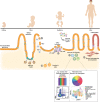Redefining intestinal immunity with single-cell transcriptomics
- PMID: 34848830
- PMCID: PMC8630196
- DOI: 10.1038/s41385-021-00470-y
Redefining intestinal immunity with single-cell transcriptomics
Erratum in
-
Correction to: Redefining intestinal immunity with single-cell transcriptomics.Mucosal Immunol. 2022 Mar;15(3):526. doi: 10.1038/s41385-022-00483-1. Mucosal Immunol. 2022. PMID: 35132163 Free PMC article. No abstract available.
Abstract
The intestinal immune system represents the largest collection of immune cells in the body and is continually exposed to antigens from food and the microbiota. Here we discuss the contribution of single-cell transcriptomics in shaping our understanding of this complex system. We consider the impact on resolving early intestine development, engagement with the neighbouring microbiota, diversity of intestinal immune cells, compartmentalisation within the intestines and interactions with non-immune cells. Finally, we offer a perspective on open questions about gut immunity that evolving single-cell technologies are well placed to address.
© 2021. The Author(s).
Conflict of interest statement
In the past three years, S.A.T has consulted or been a member of Scientific Advisory Boards at Roche, Qiagen, Genentech, Biogen, GlaxoSmithKline and ForeSite Labs. G.L.H. has consulted or been a member of Scientific Advisory Boards at Ferring, Procter and Gamble and Enterobiotix. The remaining authors declare no conflicts of interest.
Figures



References
-
- Besredka A. De la vaccination contra les ctats typhoid par la voic buccale. Ann. Inst. Pasteur. 1919;33:882.
Publication types
MeSH terms
LinkOut - more resources
Full Text Sources

